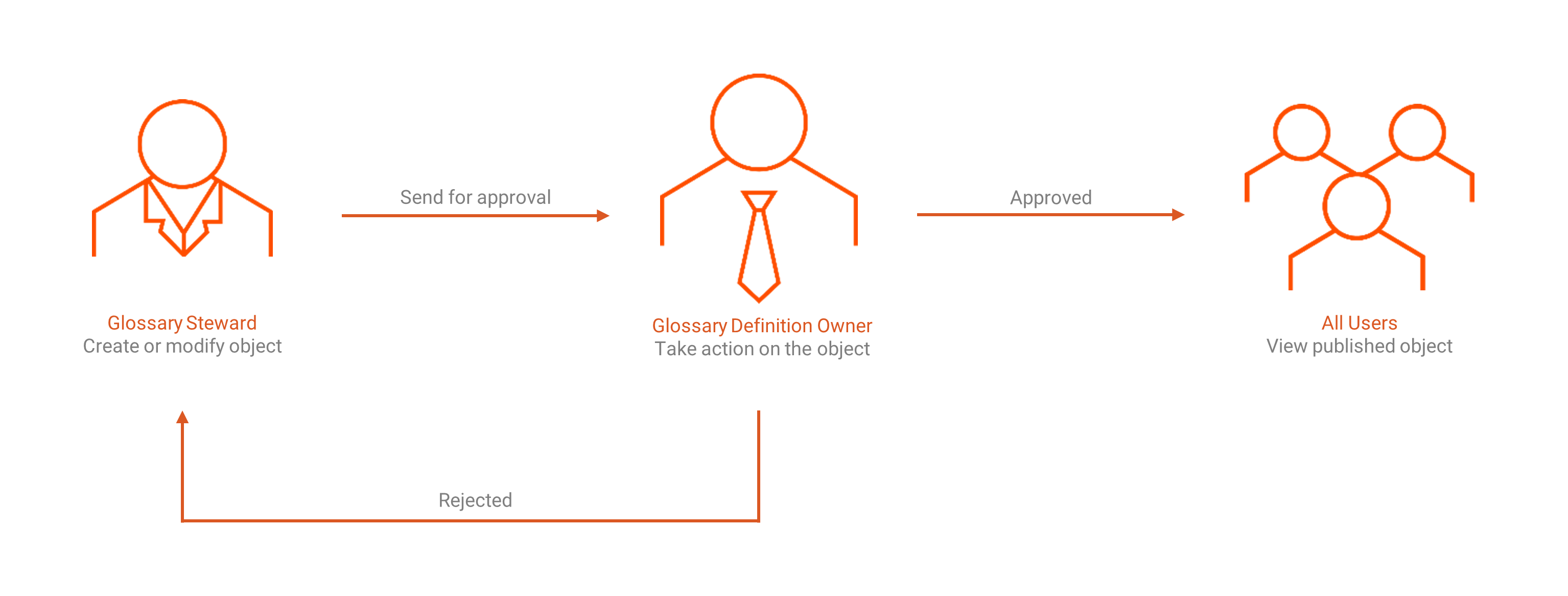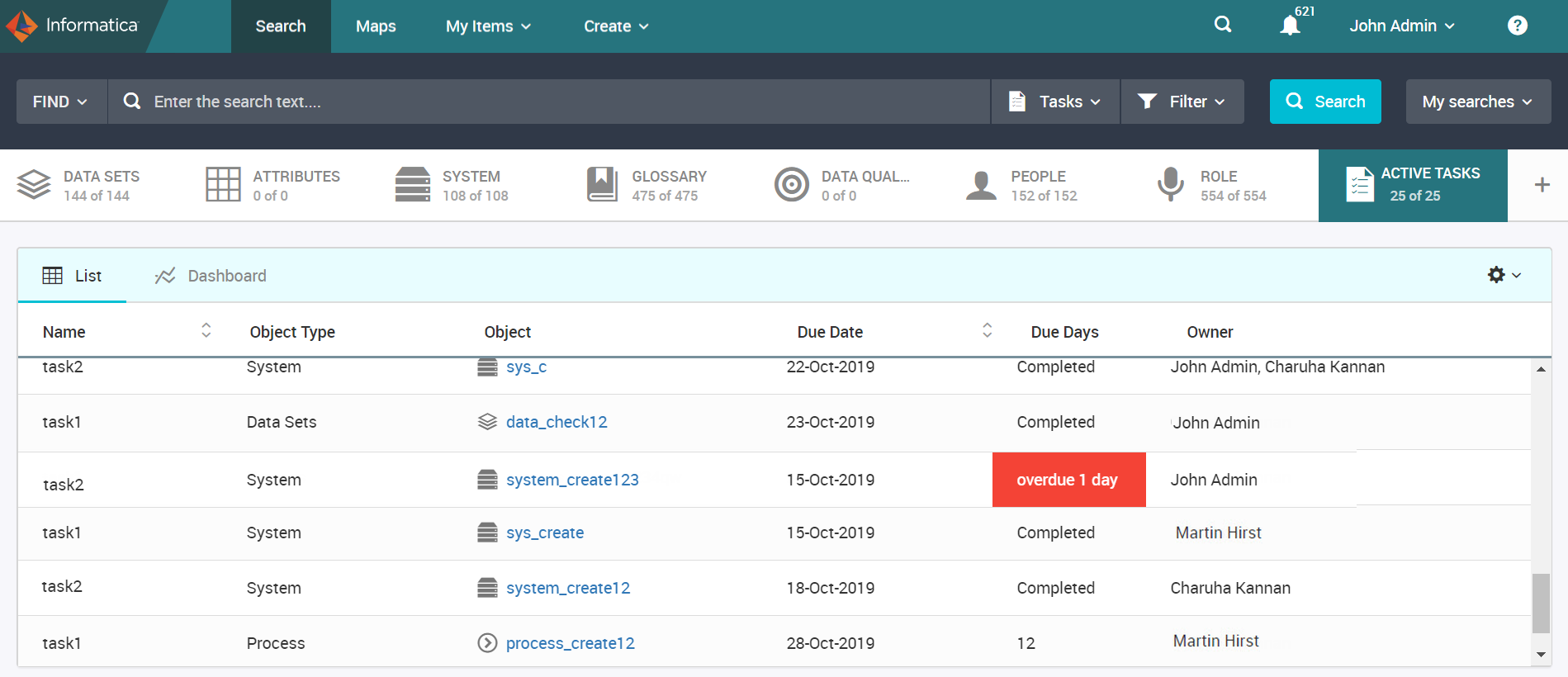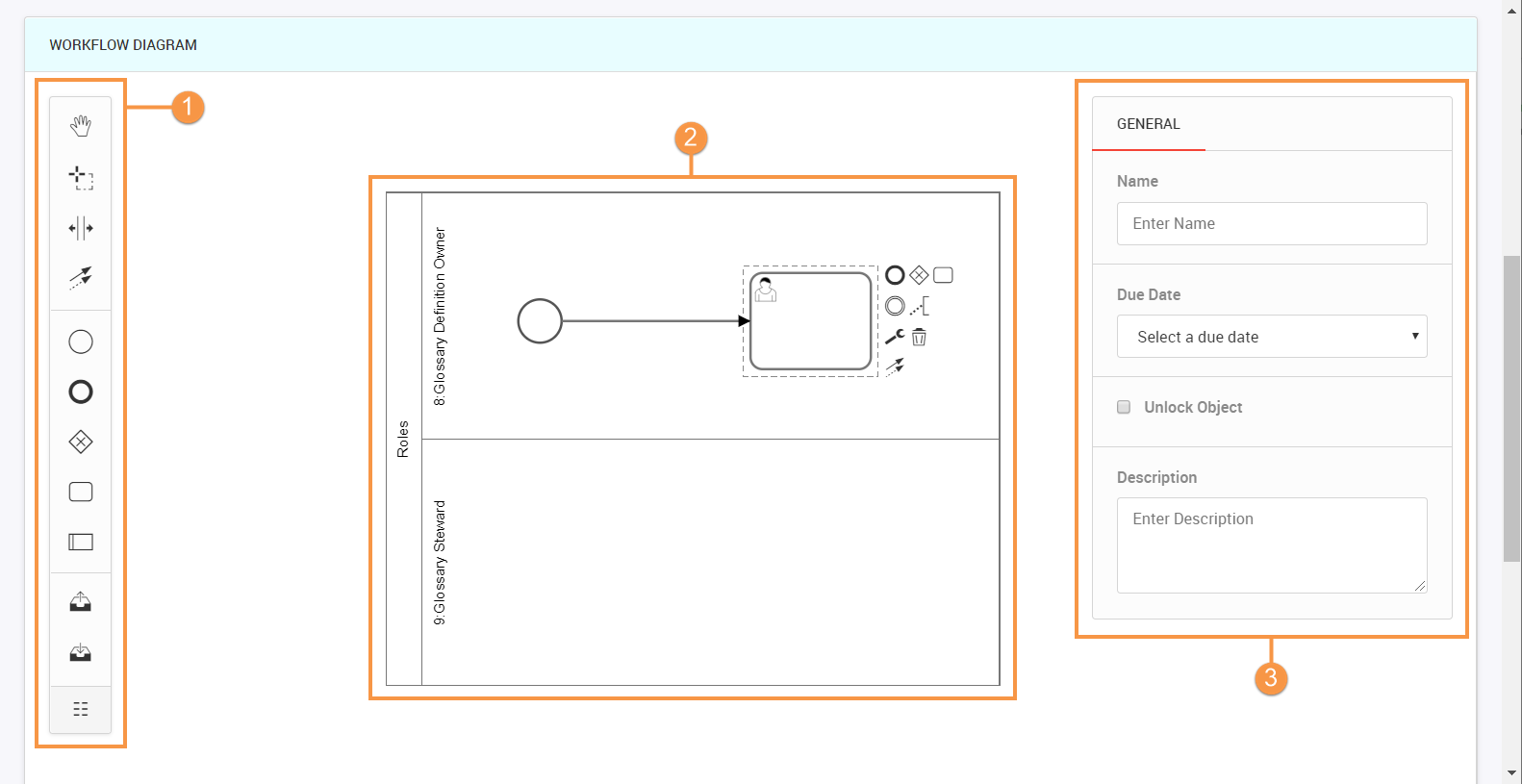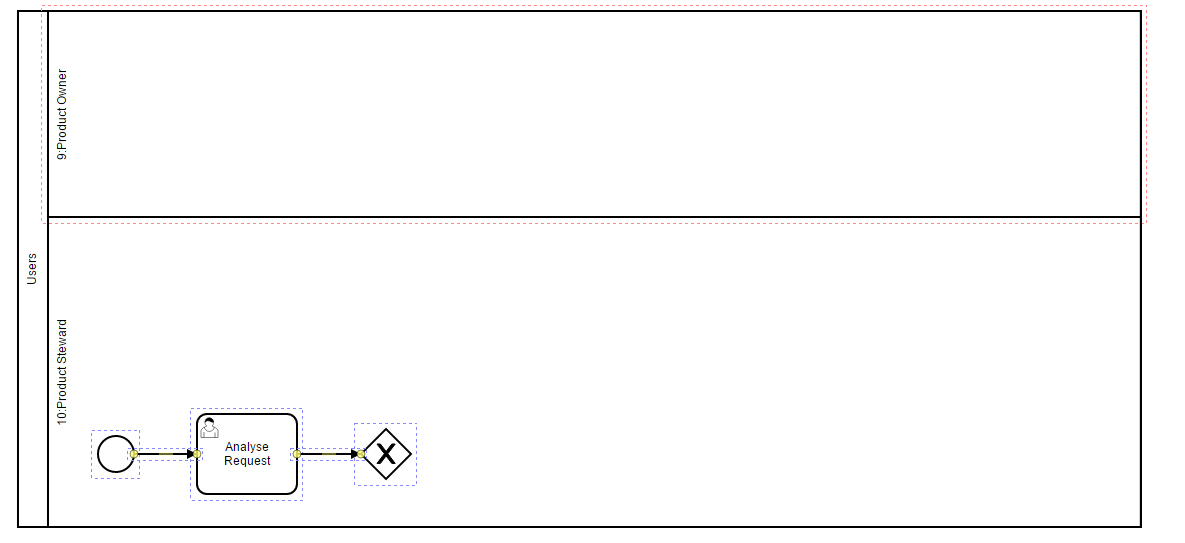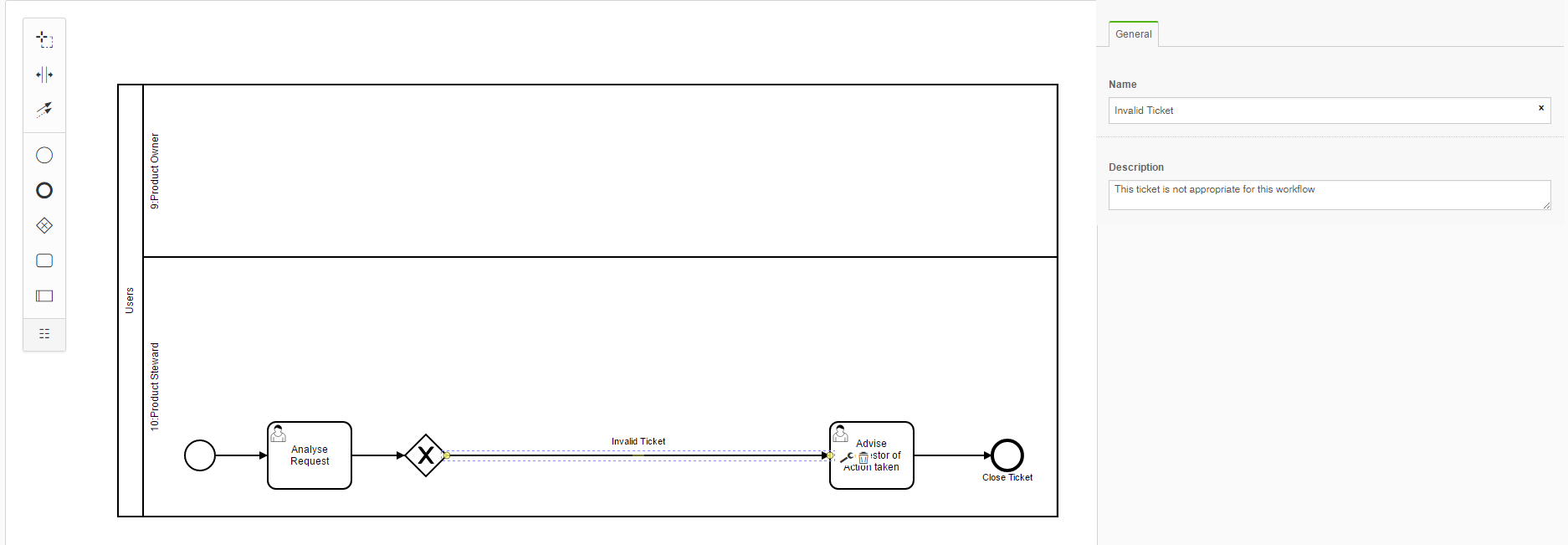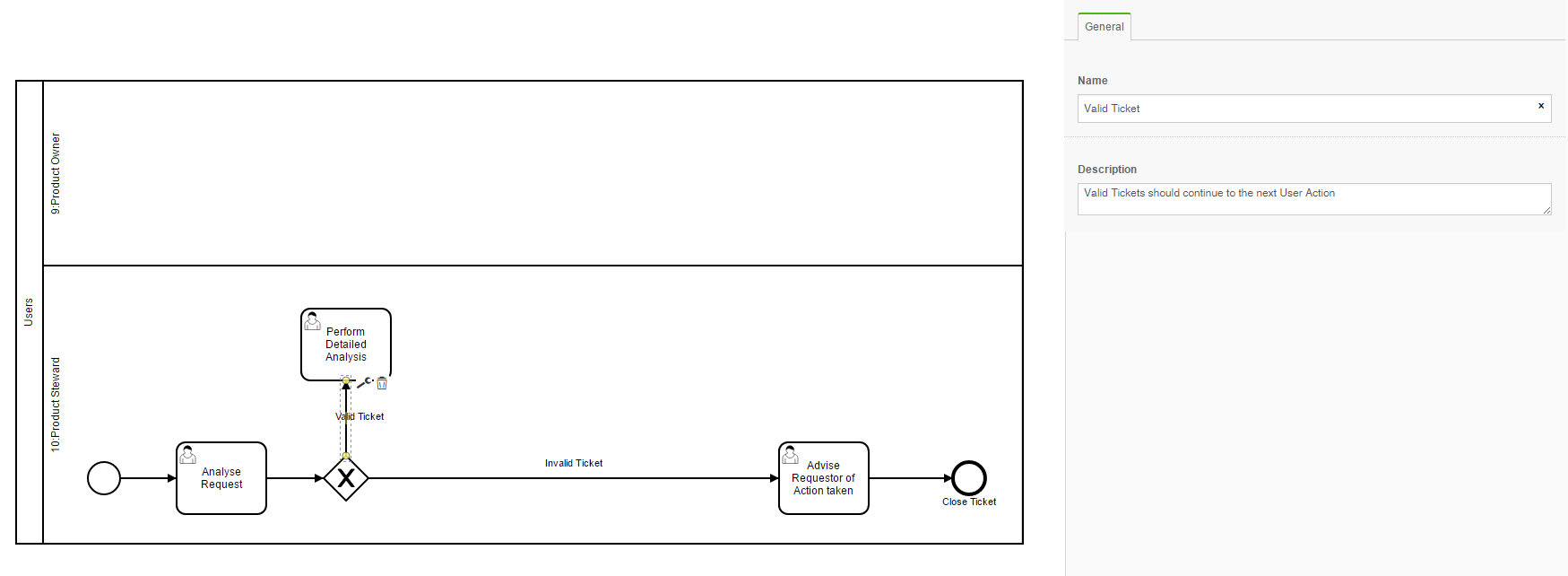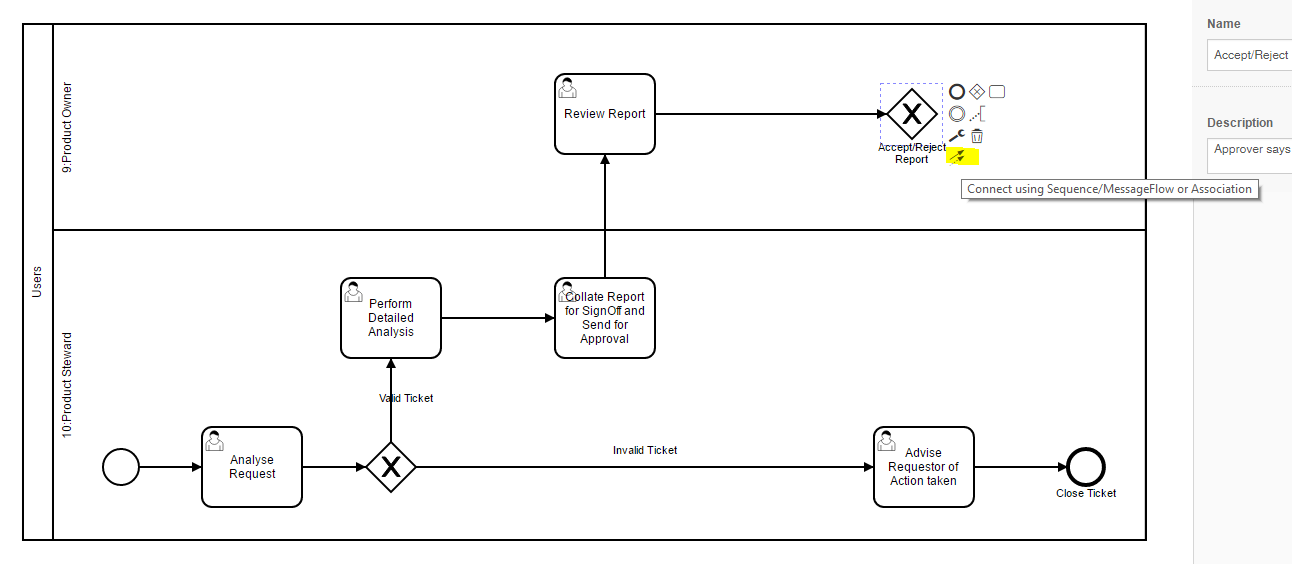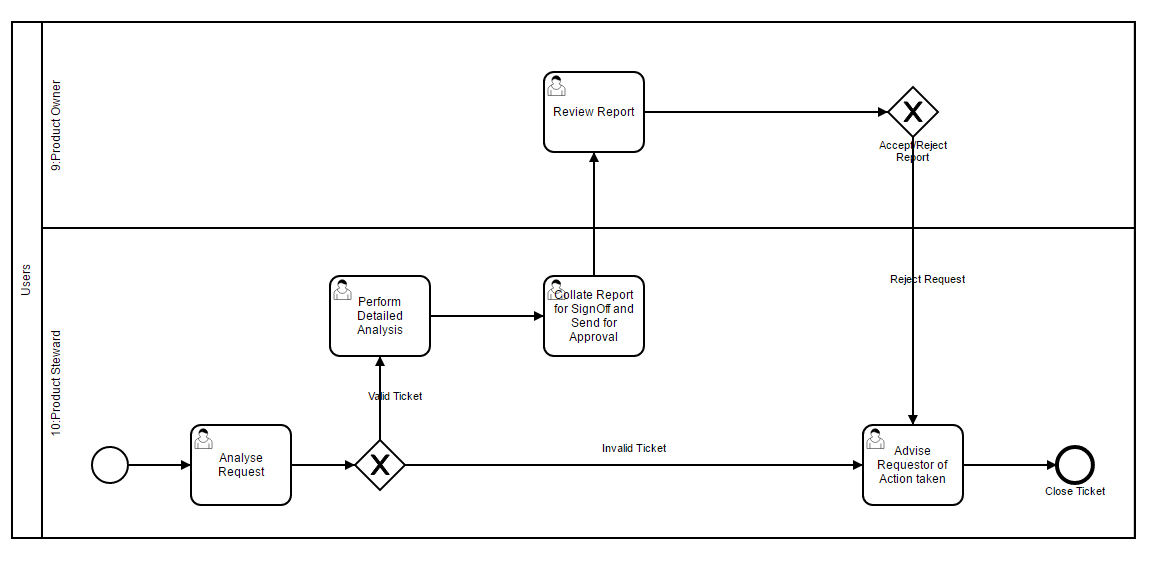Use Workflows and Create Change Requests
You can create workflows that Axon implements when users want to create or modify objects. A workflow specifies the steps to create or modify an object, and the stakeholders that must be involved in providing inputs for the change process. A user who wants to create or modify an object must raise a change request and select a workflow for the object.
Workflows Overview
You can define controls for creating and modifying objects in Axon using a workflow. A workflow is a series of predetermined steps that a SuperAdmin can define for creating or modifying an object.
A workflow ensures that the right people have the opportunity to provide input, challenge, and approve matters related to the object that is created or modified. At each step in the workflow, Axon notifies the stakeholders that they must make a decision about the object. If the workflow for a change request requires the role of approvers at various stages of the lifecycle, the approvers must approve or reject the object for the workflow to move to the next stage.
The series of steps in a workflow ensure that objects are created in Axon according to the data governance principles in your organization. Only users with the proper role and access can create or modify Axon objects. The workflows available for a change request might vary depending on the facets.
Axon includes a Business Process Model and Notation (BPMN) 2.0 workflow component to support data governance and change control functionality.
You can create default and custom workflows in Axon. A SuperAdmin user can define a default workflow for a facet, and the workflow applies to all the objects in the facet. Apart from the default workflows that the SuperAdmin has configured, an object stakeholder can define a custom workflow for a specific object within a facet.
Stakeholders in a Workflow
The stakeholders that can participate in a workflow depend on the object facet that a user wants to modify.
Facet Stakeholders
The roles that the administrator has configured for a facet become the workflow stakeholders for the facet objects. For example, if the SuperAdmin user has configured the Project Manager and Project Steward roles for the Project facet, then users that have the Project Manager or Project Steward responsibilities can participate in workflows to create or modify Project objects.
When a user raises a change request for an object, you can see the stakeholders of the change request in the following locations:
- •Open the object for which a change request is created, and go to the Stakeholders tab.
- •Open the change request from the Change Request facet, and go to the Stakeholders tab.
To create stakeholder roles for a facet, see the Configure Roles topic in the Configuring Axon chapter of the Axon Data Governance 7.0 Administrator Guide.
Requestor
Any user in the organization, including users that are not stakeholders for a facet, can raise a change request to create or modify an object. Such a user is called a Requestor. In addition to the facet stakeholders, you can add the Requestor as a stakeholder in the swimlanes of a workflow.
To see the Requestor of a change request, go to the Change Request facet and see the Created By field in the Summary tab.
Note: A change request can have only one Requestor person. After a change request is raised by a Requestor, you cannot choose another person as the Requestor.
Change Requests Overview
A change request facilitates communication and discussion between the object stakeholders and the wider Axon community.
Raise a change request to provide a controlled and audited change approval process. Assign a workflow to the change request, and run the workflow to activate the change request. The types of change requests that you can create depend on the configuration of each instance of Axon and the configured workflows. Any user that logs in to Axon can raise a change request.
To create a change request, you can use the native Axon change request system or an external system that the system administrator has configured. To connect Axon to an external change request system, see the Connect to External Change Request Systems topic in the Configuring Axon chapter of the Axon Data Governance 7.0 Administrator Guide. In this release, Axon supports the ServiceNow ticketing system.
In Axon, you can create change requests manually, or the Axon Administrator can configure automatic change requests.
- Manual Change Request
- Raise a change request manually if you want to involve stakeholders when you create or modify an Axon object. To raise a manual change request, see Create a Change Request Manually.
- Automatic Change Request
- If the Axon administrator has configured automatic change requests, Axon automatically starts a change request process when you create or modify an object. To configure an automatic change request, see the Configure Default Values for Automatic Change Requests topic in the Configuring Axon chapter of the Axon Data Governance 7.0 Administrator Guide.
You can find or track a change request in the following locations:
- •Unison Search. Change Requests have their own facet. Each change request is linked to the object that they belong to.
- •Object View. View a change request in the Change tab of an object.
- •My Account. Object stakeholders that are a part of change request workflow can find a list in the My Account | Change Request view.
- •Dashboard widgets. In the Change Requests widget, view the change requests that are assigned to you and the change requests you have raised. In the Pending Tasks widget, see your pending tasks in workflows where you are a stakeholder.
After a task starts in the workflow of a change request, Axon displays the task in the Active Tasks facet on the Unison search.
Change Request Statuses
A change request can be in one of the following statuses:
- Pending Start
- You have created a change request, but not started it. Assign and run a workflow to start the change request. If the SuperAdmin has configured mandatory workflow approvals, check for pending stakeholder roles, assign the missing stakeholders to the object, and submit your changes to start the change request.
- Running
- The change request has started, and the object moves through the stakeholders that are defined in the workflow for the object.
- Completed
- The change request is complete. The object has moved through all the stakeholders and reached the end of the workflow
- Cancelled
- The change request was cancelled in the middle of the workflow, and the object cannot be created or modified in Axon
Example of Using Workflows and Change Requests
In your organization, the data governance principles require that only a glossary steward can create or modify glossary objects, and every object must be approved by a glossary definition owner.
Roles
To create or modify a glossary term, the SuperAdmin must create the following roles in Axon:
- •A glossary steward to create the Glossary object
- •A glossary definition owner to approve the Glossary object
To create roles in Axon, see the Configure Roles topic in the Configuring Axon chapter of the Axon Data Governance 7.0 Administrator Guide.
Workflow
The SuperAdmin must also create a workflow that uses the glossary steward and glossary definition owner roles.
The following diagram represents the workflow for this example:
The glossary steward logs in to Axon and creates or modifies a glossary term. Axon does not publish the glossary object for all users. Instead, Axon sends the object to the glossary definition owner for approval. The glossary definition owner logs in to Axon and sees the notification for the object approval. If the owner approves the defintion, Axon publishes the term to make it available to all users. If the owner rejects the definition, Axon sends the object back to the glossary steward. The glossary steward can now modify the object and send it again to the definition owner for approval.
To create a workflow that you can use for a specific facet, see the Create a Default Workflow topic in the Configuring Axon chapter of the Axon Data Governance 7.0 Administrator Guide.
Change Request
When a glossary steward creates a glossary term, Axon starts a change request according to the workflow that the SuperAdmin has specified for the Glossary facet. According to the workflow, the object moves from the steward to the definition owner. If the glossary definition owner approves the term, Axon publishes the object, and the change request is complete.
Create a Default Workflow
Default workflows are specific to a facet and apply to all the objects in the facet. Each facet can have multiple default workflows. If you want multiple objects to use the same workflow, create a default workflow for the facet.
Only users with the SuperAdmin profile can create default workflows for facets. For more information, see the Create a Default Workflow topic in the Configuring Axon chapter of the Axon Data Governance 7.0 Administrator Guide.
Automatic Change Requests
The Axon Administrator might configure change requests to start automatically when you create or modify an object. An automatic change request starts a workflow that requires mandatory approval for the object. This ensures that the right stakeholders can provide inputs to the object, and all changes are approved by the authorized people.
To configure an automatic change request, see the Configure Default Values for Automatic Change Requests topic in the Configuring Axon chapter of the Axon Data Governance 7.0 Administrator Guide.
Facets that Support Automatic Change Requests
The administrator can configure Axon to create automatic change requests when users modify the following tabs and sections for facet objects:
- •Glossary
- - Summary > Definition
- - Summary > Classifications
- - Summary > Strategic Source
- - Summary > Documents
- - Relationships > Hierarchy
- - Impact
- •System
- - Summary > Definition
- - Summary > Classifications
- - Summary > Data Content Summary
- - Summary > Documents
- - Impact
- •Data Set
- - Summary > Definition
- - Summary > Classifications
- - Summary > Documents
- - Attributes
- - Relationships > Inbound Relationships
- - Relationships > Outbound Relationships
- - Values
- - Impact
- •Process
- - Summary > Definition
- - Summary > Classifications
- - Summary > Process Predecessors
- - Summary > Documents
- - Components
- - Impact
Axon creates automatic change requests when you create, modify, or delete objects from the Axon interface. If you use bulk upload to create, modify, or delete objects, Axon automatically raises change requests.
Create a Change Request Manually
Raise a change request to create, update, enhance, or request information for an Axon object. You can start a change request when you modify a default field or custom field.
The SuperAdmin must configure a workflow for the object facet in the Admin Panel.
1. Open the object for which you want to raise a change request.
2. In the Change tab of the object, click the Change Request tab.
3. Click Edit > Raise Change Request.
The New Change Request page appears.
4. Configure the following properties to define a change request:
Field | Description |
|---|
Title | Provide a short, meaningful title for the change request. |
Type | Select the option that best describes the type of change request. You can either request for a change or request for information. |
Summary | Provide a full description to explain why you want to raise the change request. The summary must contain enough information for stakeholders to assess the change request. A change request might be rejected if the details are not sufficient. |
Parent | Select a parent name if the change request is part of a collection of related requests. You can associate the change request as a child of the parent change request. |
5. Configure the following properties to classify a change request:
Field | Description |
|---|
Severity | Select the severity of the change request. You can select a low, medium, or high severity. |
Urgency | Select the level of urgency for the change request. Select low, medium, or high. |
Estimated Benefit | Enter the amount of estimated benefit after you make the change. Expressed in GBP. |
Estimated Cost | Enter the amount of the estimated cost to make the change. Expressed in GBP. |
6. Click Save and Close.
Axon creates a change request for the object, but does not start the change request. To start the change request, you must assign a workflow to the object. To select a workflow, see
Assign a Workflow to a Manual Change Request. You can view the Summary, Relationships, Stakeholders, and History tabs of the change request that you created.
Assign a Workflow to a Manual Change Request
After you create a change request, you must assign a workflow to the change request. To start the change request process, you must start the workflow. You can choose a default or custom workflow.
The following prerequisites apply to change requests that use workflows:
- •The SuperAdmin has created the workflows in the Admin Panel, and the workflows must be in the active status.
- •In the Admin Panel, the SuperAdmin has enabled default change requests for each facet. If the SuperAdmin does not enable default change requests, you can create or modify objects without using approval workflows.
1. Open the object for which you want to create a change request.
2. In the Change | Change Requests view, click the change request for which you want to run the workflow.
Before you open the change request, you can see that the change request is in the Pending Start state.
3. In the Summary tab, select a workflow from the list.
You can view the list of custom and default workflows that are applicable for the object.
4. To start the change request and run the workflow, click Start.
Note: A person with the Requestor role cannot start a change request.
Axon displays a message that the workflow is initiated. The stakeholder can add comments and complete the tasks based on the tasks specified for different roles in the workflow.
Review a Change Request
If you are a stakeholder in a change request process, you can provide your inputs for creating or modifying an Axon object. Your role in the change request is determined by the workflow that the Axon Admin or SuperAdmin assigns to the object. Review the change requests assigned to you and provide your inputs.
For more information on workflows, see
Workflows Overview.
1. Open the object with a change request that you want to review.
The object is in the Running state.
2. In the Change tab of the object, click the Change Request sub-tab.
The page displays the list of objects for which you have change requests.
3. Click an Axon object in the list to open the object.
The object opens in a new window, and the Summary tab is displayed by default.
4. Verify the information in the Changes to Review section. The Changes to Review section displays the changes that stakeholders have made to the object during the lifecycle of the change request.
Note: The Changes to Review section is displayed for change requests that are in progress. If a stakeholder completes or cancels a change request, the Changes to Review section does not appear.
5. Review your role in the workflow, and provide your inputs on the Axon object. For example, if the change request requires that you start a workflow, you might have to scroll down to the Workflow section of the page and click Start. If you are participating in a workflow that is started by another user, you might have to click Approve.
If the Summary tab of the object is under revision, the top of the page displays the status of the object. You can see whether the page displays the original version or modified version of the object.
6. To complete the workflow, click Complete in the Classifications section of the page.
Note: A person with the Requestor role cannot complete a workflow.
If a SuperAdmin user has configured auto-completion of change requests, Axon automatically marks the change request as complete when the object reaches the end of the workflow.
If you have new Attribute objects that are in the middle of a workflow process, Axon does not assign reference numbers to the objects. When you go to the Attributes tab of the related data set, the Ref column for the Attribute objects do not display any value. In such cases, you cannot bulk update the objects. After the workflow is complete, Axon assigns reference numbers to the objects, and you can then bulk update the Attribute objects.
Assign a Delegate in a Workflow
When a change request workflow is stuck, an Admin user or an object stakeholder with edit permissions can help progress the workflow.
A workflow gets stuck due to the following reasons:
- •The responsible user might not be available to complete the action in the active workflow step.
- •A required stakeholder role might be vacant during the life of the change request.
To allow the progress of a workflow, you can add a user to the required role as a delegate of an existing role if the role is vacant. Allow the user take the appropriate action, and approve the step when complete. Then, remove the user from the role for the task. You must add an entry to the Discussion section of the Change Request to record the actions that you take. You can also view the updates to the change request from the History tab of the Change Request.
Note: The workflow can get stuck only during the progress of a workflow. If a user role is vacant, you cannot assign the workflow to a Change Request object .
View Audit Trail of a Change Request
When you run a workflow, Axon notifies the stakeholders of the tasks that they need to perform as part of the change request. A stakeholder can review and take necessary actions for the change request. After you start the workflow, the workflow diagram shows the active task in green color.
The Discussion section of the workflow contains an audit trail of all the steps for which actions are taken or discussions are held. For example, you can see the task name, status, description, and due date for a user task. You can use the @ special character to address the user in a discussion. When a user is assigned to perform a task, Axon invites the user to post the results and shows the relevant actions that the user needs to perform to complete the task. If a user task is followed by a gateway, the user has an option to capture the decision made as part of the user task.
After all the responsible stakeholders complete the tasks, the designated stakeholder can close the change request.
View Active Tasks of Change Requests
You can view the active tasks that are defined within the workflow of a change request. Once a task starts, it appears under the Active Tasks facet. After the task is complete, it disappears from the Active Tasks facet.
To view the Active Tasks facet on the Unison search page, click the + icon and select Business & Change > Active Tasks. You can view outstanding workflow tasks from the Active Tasks facet.
You can search for active tasks that are associated with objects or individuals. When you perform a Unison search, you can apply filters based on due days and due dates for the Active Tasks facet. You can apply the following filters:
- •Due Date From
- •Due Date To
- •Due In (days)
- •Due Date Overdue
You can save searches for active tasks and add widgets to appear as a number count or table in a dashboard. Use the active tasks dashboard to monitor the outstanding tasks.
The following image shows the Active Tasks facet view on Unison search:
You can view the following task information on the Unison grid:
- Name
- Name of the active task.
- Object Type
- The type of the object in which the active task is present.
- Object
- The object that contains the active task.
- Due Date
- The date by which the active task needs to be completed.
- Due Days
- The number of days by which the active task is due.
- Owner
- The owner of the active task within the object.
If a name is not provided for a task in a workflow, the task does not appear in the Active Tasks facet. If a due date is not specified for a task in a workflow, the Due Days column of the Active Tasks facet displays the value as "Not Specified."
Create a Custom Workflow
If you want an object to follow one or more specific workflows, create a custom workflow for the object. A stakeholder with edit permissions can create a custom workflow.
1. Click the object for which you want to create a custom workflow.
2. Click Edit.
The object opens in the edit mode.
3. Click the Workflow tab.
4. Choose to add a new workflow.
5. Enter a name for the workflow.
The name must contain a minimum of six characters.
6. Provide a description for the workflow.
Axon creates a canvas with many swimlanes based on the roles that are defined for the facet.
7. In Workflow Diagram section, create a workflow diagram on the canvas. Create swimlanes to assign tasks to the facet stakeholders or Requestor. Use the Toolbar to add objects and connect them. Use the Properties panel to specify additional properties for the objects.
8. Click Save.
Workflow Designer
Axon implements a visual editor to create and run a workflow from a browser.
When you provide a name and description for a new workflow, Axon creates a canvas to create a workflow diagram. The Workflow Diagram section has three components: a toolbar on the left, a canvas in the center, and a properties panel on the right.
The following image shows the different sections of a workflow diagram:
- 1. Toolbar
- 2. Canvas
- 3. Properties
Toolbar
Use the toolbar to create a workflow diagram. The toolbar has three sections. The top section contains tools to select the items, resize the canvas, and connect the items. The middle section lists the building blocks of the workflow. You can select the items and drag to the canvas to create the workflow. The bottom section contains tools to show or hide the toolbar.
The following table describes the different tools that you can use to create a workflow diagram:
Tool Name | Description |
|---|
Hand | Use the hand tool to select an item. |
Lasso | Use the lasso tool to select a block on the swimlane. |
Create/Remove Space | Use the create or remove tool to increase or decrease the canvas size. |
Global Connect | Use the global connect tool to connect the items in a workflow. |
Create StartEvent | Use the Create StartEvent tool to start a workflow event. You can decide the role that can start the event. |
Create EndEvent | Use the Create EndEvent tool to end a workflow event. You can decide the role that can end the event. |
Create ExclusiveGateway | Use the Create ExclusiveGateway tool to create decision boxes that can have two results. For example, a validate request can have two values: accept and reject. A gateway and the preceding user task must be close to one another in the same swimlane because they both are a logical unit and must be performed by the same user. |
Create UserTask | Use the Create UserTask tool to create tasks that a user can perform. You can enter a name, due date, and description for a user task. You can create user tasks such as validate request, capture impact assessment, confirm feasibility, and approve request. |
Create Pool/Participant | Use the Create Pool or Participant tool to add a swimlane for a user role. |
Upload BPMN | Use the Upload BPMN tool to upload a workflow diagram to the canvas. |
Download BPMN | Use the Download BPMN tool to download a workflow diagram from the canvas. |
Hide/Show | Use the Hide or Show tool to hide or show the toolbar. |
Canvas
The canvas provides a visual representation of the workflow. When you create a custom or default workflow, Axon automatically creates an empty canvas with swimlanes for each role that is defined for a facet. For example, if a Glossary facet has four roles, Axon creates four swimlanes, one for each role.
Select a swimlane and drag a corner to resize the canvas vertically and horizontally. Select items from the toolbar, drag them to the canvas, and connect them. When you place an item on the canvas, you can click the item to view the toolbar options that are relevant to the object.
BPMN workflows use swimlanes to capture who is responsible for a set of tasks. The tasks that you specify in a swimlane becomes the responsibility of the role associated with the swimlane. If one or more roles do not contain any task in the workflow, you can leave the swimlanes empty or delete the swimlanes. If you want to create the swimlane again, you can use the tool bar to create a swimlane and you must specify the role name and the correct role ID.
Properties
In the Properties panel, you can specify additional properties for the items or tasks on the canvas. The properties that appear depend on the tool that you add to the workflow. All properties do not appear for all tools.
The following table describes the properties that you can configure:
Tool Name | Description |
|---|
Name | Name of the workflow step. If you click a role in the workflow canvas, select the object stakeholder or requestor that participates in the workflow step. |
Due Date | Date by which the workflow step must be completed. |
Description | Description of the workflow step. |
Axon Status | Status of the object during the workflow step as it appears in the Axon Status field. |
Lifecycle | Lifecycle of the object during the workflow step as it appears in the Lifecycle field. |
Unlock Object | Select the check box to unlock the object at a specific step in the workflow. If you do not select the check box, the object remains locked. |
Commit Changes | Select the check box to save the object with the changes and apply the values that you specified in the Axon Status and Lifecycle fields. This check box is typically selected when the workflow has reached the last step and a stakeholder has approved the changes to the object. Clear the check box to not save the object. This check box is typically cleared when the workflow has reached the last step and a stakeholder has rejected the changes to the object. |
If you have a gateway in a workflow, you must specify the labels for the lines that start from the gateway. The labels need to be short and unique. The labels serves decision routing actions when you run the workflow.
Workflow Diagram Example
The example shows a new Default Workflow being created. Apart from the different start point, the functionality to build the workflow is identical. The facet used in this example is Product. After you select the Product facet, you can see that one default workflow already exists. You can either select this one to edit, or create another.
1. From the Axon toolbar, click Admin Panel under the user name.
The Admin Dashboard appears with the Axon version details, status of Axon services, and Axon message queues.
2. On the left navigation pane, click DG Operating Model > Default Workflows.
3. Select the Product facet for which you want to configure a workflow.
4. Choose to add a new workflow.
5. Enter a name for the workflow.
The name must contain a minimum of six characters.
6. Provide a description for the workflow.
Axon creates a canvas with many swimlanes based on the roles that are defined for the facet. Remember that the swimlanes appear with a lane for each type of stakeholder role configured for the facet, that is for the Product Steward, Product Owner role.
7. Click into one of the lanes, so that a dotted line appears, and use the bin icon on the menu to delete this lane. You can add it back in later if required.
8. From the toolbar, choose the Start Event, and place it in the Steward’s swimlane. This means that the objects stewards receive the first request to action when a ticket is raised against this request.
9. Typically the first thing that anyone does is to validate that the request should have been routed to this workflow. If OK, then do something. If Not OK, inform the requestor and close the ticket.
10. The first step is to raise a User Action, and populate the Properties on the right.
- a. Click into the Start action.
- b. From the options cloud that appears, choose the User Action and drop it in the Steward's swimlane.
A line automatically appears between the two concepts.
The following image shows the start step and the first user task of the workflow:
The User Action can be populated by completing the Properties section, as above.
11. Next, you need a Gateway to show that there are two options - accept as valid request or reject.
- a. Click in the User Action and the same option cloud appears as before. This time select the diamond shaped concept, ensuring that it is placed in the Steward's swimlane.
- b. In the next picture the user has increased the horizontal width of all swimlanes, increased the height of the Steward's swimlane, and finally used the lasso tool on the Toolbar to grab and move the concepts you have created so far to the bottom of the swimlane.
The following image shows the increased length of the swimlane:
12. Now, you can add the two possible paths. First, an invalid request needs a User Action to Inform the user and then a Close Action.
- a. Always remember to click the predecessor object, create the User Action, and close the workflow. Remember to populate the Properties for each object.
- b. Lines leaving a gateway MUST have a name added to them, because these will appear in the any active workflow as labels on the Accept/Reject buttons. Keep them short and clear.
The following image shows the workflow diagram with the user task:
13. If you want to leave the Gateway on the alternative (valid request) path, then you need to create the next User Task.
This step is to ‘Perform Detailed Analysis’, and has been created in the picture below. As you can see, this is also performed by the Product Steward.
The following image shows the workflow diagram with the user task:
14. After some additional tasks by the Steward shown as an additional User Task (Collate Report) in the same swimlane, it is time to send to the Product Owner user for review and approval.
This time, from the option cloud on the ‘Collate Report’ User Action, simply drag the User Action into the Owner’s swimlane, and fill in the Properties.
The following image shows the properties that you can fill in for the user task:
15. As the possible actions are to either accept or reject the findings in the report, you need a Gateway to show these two alternatives. If the Owner rejects the report, then you should connect this new Gateway to the User Action already created to ‘Advise Requestor of Action taken’, and then you close the workflow.
The following image shows the alternatives for the gateway:
16. As this Gateway and the User Action both already appear on the page, you need to do something slightly different to connect them.
- a. Click on the Gateway, and select the lines icon, from the option cloud.
- b. Once clicked simply move your mouse toward the ‘Advise Requestor…’ User Action, and a line will be drawn between them.
- c. Remember to go back to this new line and name it. Click in the line between the two concepts and fill in the Properties. The line’s name will later appear in the workflow step when the Owner has to accept/reject the step.
The following image shows the workflow with the Reject path complete:
17. If the reviewed report is accepted, add something in to show what happens. The Steward is expected to implement the report, so create a User Action in the Steward’s swimlane.
The following image shows the action added to the steward role:
18. Save and close the workflow.
you now have a completed workflow. All paths ultimately lead to the Close event. All lines leading FROM a Gateway have a name, which creates the approve/reject buttons in a live workflow.
19. When a Change Request is raised against the workflow, you can see the CR on the canvas.
You can see that:
- a. The Active Step, i.e. the step awaiting action is Green. If orange it is alerting users that the Due By Date is less than a day away.
- b. The description that was created for this workflow step (in the Properties section) appears as guidance on the action expected by the Steward in the Discussion section below the canvas..
- c. There are two green buttons in the Discussion, which allow the Steward to accept/reject the step. They have the same names as the lines that leave the Gateway immediately after the active User Action.
The following image shows the workflow diagram for the change request:
